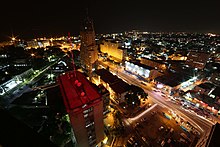
Back اقتصاد جمهورية الكونغو الديمقراطية Arabic Economía de la República Democrática d'El Congu AST Economia de la República Democràtica del Congo Catalan Wirtschaft der Demokratischen Republik Kongo German Economía de la República Democrática del Congo Spanish Économie de la république démocratique du Congo French Economía da República Democrática do Congo Galician Կոնգոյի Դեմոկրատական Հանրապետության տնտեսություն Armenian Ekonomio di Demokratial Republiko Kongo IO 콩고 민주 공화국의 경제 Korean
 Kinshasa, capital and economic center of the Democratic Republic of the Congo | |
| Currency | Congolese Franc (CDF) |
|---|---|
| Calendar year | |
Trade organisations | AU, AfCFTA (signed), AfDB, SADC, COMESA, ECCAS, SADC, WTO, Group of 77 |
Country group | |
| Statistics | |
| Population | |
| GDP | |
| GDP rank | |
GDP growth |
|
GDP per capita | |
GDP per capita rank | |
GDP by sector |
|
| 5.0% (2020 est.)[4] | |
Population below poverty line | |
| 42.1 medium (2012)[8] | |
Labour force | |
Labour force by occupation | N/A |
| Unemployment | 4.5% (2022) |
Main industries | mining (copper, cobalt, gold, diamonds, coltan, zinc, tin, tungsten), mineral processing, consumer products (including textiles, plastics, footwear, cigarettes, processed foods, beverages), metal products, lumber, cement, commercial ship repair |
| External | |
| Exports | |
Export goods | gold, diamonds, copper, cobalt, coltan, zinc, tin, tungsten, crude oil, wood products, coffee |
Main export partners |
|
| Imports | |
Import goods | machinery, transportation equipment, fuel, food |
Main import partners | |
Gross external debt | |
| Public finances | |
| Revenues | $4.943 billion (2018 est.) |
| Expenses | $5.198 billion (2018 est.) |
All values, unless otherwise stated, are in US dollars. | |
The economy of the Democratic Republic of the Congo has declined drastically around the 1980s,[15] despite being home to vast potential in natural resources and mineral wealth; their gross domestic product is $69.474 billion as of 2023. During the last five reported years the exports of Democratic Republic of the Congo have changed by $15.2B from $13.3B in 2017 to $28.5B in 2022.
At the time of its independence in 1960, the Democratic Republic of the Congo was the second most industrialized country in Africa after South Africa. It boasted a thriving mining sector and its agriculture sector was relatively productive.[16] Since then, decades of corruption, war, and political instability have been a severe detriment to further growth, today leaving DRC with a GDP per capita and a HDI rating that rank among the world's lowest and make the DRC one of the most fragile and according to United Nations, least developed countries in the world.
Despite this the DRC is quickly modernizing; it tied with Malaysia for the largest positive change in HDI development in 2016. Government projects include strengthening the health system for maternal and child health, expansion of electricity access, water supply reconstructions, and urban and social rehabilitation programs.
- ^ "World Economic Outlook Database, April 2019". IMF.org. International Monetary Fund. Retrieved 29 September 2019.
- ^ "World Bank Country and Lending Groups". datahelpdesk.worldbank.org. World Bank. Retrieved 29 September 2019.
- ^ "Population, total - Congo, Dem. Rep". data.worldbank.org. World Bank. Retrieved 3 March 2020.
- ^ a b c d e "World Economic Outlook Database, April 2023". IMF.org. International Monetary Fund. Retrieved 6 December 2019.
- ^ "Global Economic Prospects, January 2020 : Slow Growth, Policy Challenges" (PDF). openknowledge.worldbank.org. World Bank. p. 147. Retrieved 23 January 2020.
- ^ "Poverty headcount ratio at national poverty lines (% of population) - Congo, Dem. Rep". data.worldbank.org. World Bank. Retrieved 3 March 2020.
- ^ "Poverty headcount ratio at $1.90 a day (2011 PPP) (% of population) - Congo, Dem. Rep". data.worldbank.org. World Bank. Retrieved 3 March 2020.
- ^ "GINI index (World Bank estimate) - Congo, Dem. Rep". data.worldbank.org. World Bank. Retrieved 3 March 2020.
- ^ "Human Development Index (HDI)". hdr.undp.org. HDRO (Human Development Report Office) United Nations Development Programme. Retrieved 11 December 2019.
- ^ "Inequality-adjusted Human Development Index (IHDI)". hdr.undp.org. HDRO (Human Development Report Office) United Nations Development Programme. Retrieved 11 December 2019.
- ^ "Labor force, total - Congo, Dem. Rep". data.worldbank.org. World Bank & ILO. Retrieved 3 March 2020.
- ^ "Employment to population ratio, 15+, total (%) (national estimate) - Congo, Dem. Rep". data.worldbank.org. World Bank & ILO. Retrieved 3 March 2020.
- ^ "Export Partners of the Democratic Republic of the Congo". The Observatory of Economic Complexity. Retrieved 21 April 2023.
- ^ "Import Partners of the Democratic Republic of the Congo". The Observatory of Economic Complexity. Retrieved 21 April 2023.
- ^
 This article incorporates text from this source, which is in the public domain: "Congo, Democratic Republic of the". The World Factbook. Central Intelligence Agency. Archived from the original on 18 October 2000.
This article incorporates text from this source, which is in the public domain: "Congo, Democratic Republic of the". The World Factbook. Central Intelligence Agency. Archived from the original on 18 October 2000.
- ^ Centre National d'Appui au Développement et à la Participation Paysanne CENADEP (23 October 2009). Province orientale :le diamant et l'or quelle part dans la reconstruction socio - économique de la Province ? (Report). Archived from the original on 25 November 2009.
© MMXXIII Rich X Search. We shall prevail. All rights reserved. Rich X Search